Review of the Mora Companion MG Knife
by Warrior Publications, May 22, 2015
Mora is the name of a town in Sweden, as well as a knife making company renowned for producing good quality but inexpensive knives (Mora of Sweden). The Mora Companion is probably one of the most popular and recommended knives among those involved in bushcrafting or other outdoor wilderness activities. Many survival and bushcraft schools and instructors use and/or recommend the Companion as a primary knife choice.
The Mora Companion MG is a lightweight utility knife intended for general outdoor use (the MG stands for military green, the colour on the handle and of the sheath). It has a clipped point blade about 4 inches (105 mm) long, and an overall length of 8.5 inches (220 mm). The blade is fairly thick at around 2.5 mm on the spine (compared to some other Mora knives), but is a little narrow at just 2 cm wide (from spine to edge). The weight of the knife is around 4 ounces (116 grams).
Like most Mora knives, the Companion has a Scandi grind and comes very sharp from the factory . The model I have is stainless steel (Sandvik 12C27). This steel is hardened to HRC 56-58 (the carbon version has an HRC of 58-60). The knife tang narrows and extends into the handle about 3/4 of the way in.
The handle is molded rubber and plastic. The rubber (which is coloured black on the MG) has a grippy texture even when wet, while the hard plastic (military green) is on the bolster area (where the blade meets the handle) and butt. Like most Scandinavian knives, the Companion does not have a full guard. Instead, the handle sweeps in leaving a small bump on the bolster where there would otherwise be a guard.
Mora has always been known for their simple sheaths, and the Companion MG is no exception. It comes with a one-piece hard plastic sheath in military green. There is a belt clip that forms the upper part of the sheath. There is also a small drainage hole at the bottom. The knife is secured in the sheath by friction fitting the upper portion of the handle (the hard plastic guard). There is a small thumb ramp (actually more of a stud) on the back of the sheath to assist in drawing the knife. The sheath only comes in a right-handed version.
Overall, the design of the Companion is slim and sleek. The widest portion of the sheath (without the thumb stud) is 1.5 inches (around 4 cm). The knife blade is a bit over .75 of an inch wide (around 2 cm), while the handle is a bit under 1.25 inches (a bit less than 3 cm).
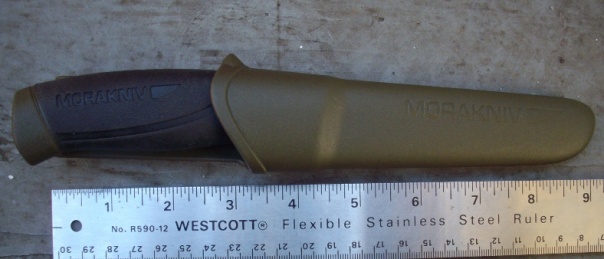 Along with the MG there are also other colour versions, such as black, orange, blue, green, and magenta. The only difference to the MG is the colour of the handle and sheaths. They are sold as Companions in either stainless or carbon steel versions. Another variation are Companions with serrated blades along most of their length (these are more for workers who need to cut lots of cardboard, tape, etc).
Along with the MG there are also other colour versions, such as black, orange, blue, green, and magenta. The only difference to the MG is the colour of the handle and sheaths. They are sold as Companions in either stainless or carbon steel versions. Another variation are Companions with serrated blades along most of their length (these are more for workers who need to cut lots of cardboard, tape, etc).
There is also a Companion Heavy Duty MG, which has a thicker 3.2 mm blade and only comes in a carbon steel version (as well as Companion Heavy Duty in various colours).
The Mora Companion MG is itself an updated version of the Clipper, formerly produced by Frosts (which merged with KJ Erikson, another Swedish knife maker, to form Mora of Sweden in 2005). The two knives are very similar in appearance, the main difference being that the Clipper has a checkered handle, while the Companion does not. The Companion also has a longer tang than the Clipper had.
I purchased my Companion MG for $18.99 (plus about $5 postage) from a Canadian distributor (BushcraftCanada.com).
Review
The Companion MG is a very comfortable and lightweight knife. The handle is ergonomic and conforms to the shape of your palm and fingers, providing a very natural and firm grip. The back of the handle is also flattened and smooth, so that you can place your thumb there for greater control during certain types of cutting techniques. The handle shape of the Companion also enables the knife to be comfortably and securely held in a number of different hand grips, useful for various types of cutting tasks. These factors, combined with the extreme sharpness of the Scandi grind, make the Companion an excellent wood carving and general utility knife. It is easy to control and can be used over extended periods of time for carving tasks without tiring your hands, as is the case with larger, thicker, and heavier knives.
I chose the stainless steel version of the Companion as I live in a coastal rainforest environment, and carbon steel tools tend to rust very quickly. Some people prefer carbon because it is a bit easier to sharpen, and you can use it to strike flint for fire starting. But I think not having a rusty knife is more important.
Due to its light weight, the Companion is easy to use as an everyday carry (EDC), just as its name implies. When worn around a belt, the knife is hardly noticeable and does not pull down on either the belt or your pants. This is an important but sometimes underestimated feature of the Companion—because it is light and easy to carry, it is more likely to be on your person in an emergency or survival situation. Large heavy knives can become a burden and are more likely to be left behind for this reason. Some people also carry the Companion as a neck knife.
Despite its light weight, the Companion still feels sturdy and durable, largely due to the thickness of the blade. Being slightly thicker than some other Mora models, the Companion isn’t as great at thinly slicing vegetables, for example. And it requires a bit more control when making fine cuts on wood than a thinner carving knife would. But the extra blade thickness makes it more durable for harder tasks such as batoning (some people do use the Companion for batoning and splitting smaller diameter wood, although I myself would avoid doing so except in a survival emergency where I needed to access dried inner wood for fire making).
With an increasing interest in bushcraft over the last few years, and a growing market for bushcraft specific knives, Mora has launched several new models. These include the Bushcraft Black as well as the Companion Heavy Duty. Their main difference with the Companion is in having a 3.2 mm thick blade, as opposed to the 2.5 mm thickness on the Companion. This is in keeping with the trend towards thicker blades over the last few years, but in my opinion the Companion is a good compromise in that it has a relatively thick blade but is still very effective in carving. Any thicker and you start to lose that finer carving capability. The Bushcraft Black and Companion Heavy Duty do not come in a stainless steel version, either.
One other difference between the Bushcraft Black and the Companion is that the Black has a sharpened spine that enables it to be used with a ferrocerium rod (ferro rod, also known as a fire steel). A common modification people make to the Companion, however, is to file the spine flat, either near the handle or towards the tip, so that a ferro rod can be used with it to produce sparks for fire lighting.
In my opinion, although promoted as a superior and specialized bushcraft knife, the Black is not worth the price, which is at least twice as much as the Companion.
In a survival situation, the Mora Companion would be a good knife to have in that it can effectively accomplish the most important tasks (at least in a North American environment) such as fire making (light batoning to split wood, carving feather sticks, making a friction fire bow drill, etc), shelter construction (cutting and smoothing small saplings or large branches), food preparation (cutting bark for cambium, skinning/gutting fish, birds, and animals, cutting vegetables etc) carving of tools and traps, as well as self-defence.
On the other hand, if you are not in a survival situation, this type and size of knife is best used in conjunction with a larger chopping tool (such as a small axe or tomahawk, a kukri or other large heavy-bladed knife) and a small folding saw. With these three tools, larger pieces of wood can be processed more effectively, leaving knives such as the Mora Companion for finer carving and utility work.
For people who are new to bushcraft or outdoor activities, the Mora Companion is an excellent starter knife in that it is inexpensive and yet of very good quality. And Scandi grinds are among the easiest knife grinds to sharpen in that there is only one fairly large bevel that is laid flat on a sharpening stone. Along with its synthetic handle and sheath, these factors make the Companion more easily maintained than other types of knives. If you live in a coastal or rainforest environment, the stainless steel version makes a better choice as well.
If there’s any criticism of the Companion, it’s the sheath. Personally, I like the sheath because it’s slim and unobtrusive, and the belt loop clip makes it very easy to add or remove from your belt. The problem is with the retention. When you first get the Companion it’s pretty tightly held in the sheath, so that drawing it takes a bit of technique. You need to grasp the handle and use your thumb to push off the thumb stud, although the way the belt loop pressed up against the handle it doesn’t offer much space to grip the handle. But that’s a minor issue. A more important one is that, according to some reviewers of the Companion, over time the friction fit of the handle into the sheath becomes worn down, so that the knife can more easily fall out of the sheath. Many people place a cord, either paracord of elasticized shock cord, around the upper belt loop and fasten this over the handle. Another reviewer stated that in extreme cold, the sheath also becomes loose. A popular modification with the Companion is, not surprisingly, making your own sheath.
Overall, this is an excellent knife and very good value for the money.
Youtube video reviews of the Mora Companion
Mora Companion Knife: Economical and Excellent
By EverydayTacticalVids, Published on May 21, 2014. Good brief video review, with a demonstration of batoning with the Companion.
https://www.youtube.com/watch?v=LxkkpfpJ4bs
Mora Knife Sharpening And Maintenance – Ben Orford Tutorial
By Zed Outdoors, Published on Jun 3, 2014. Long but in-depth video on Mora knife sharpening and maintenance.
Posted on May 22, 2015, in Gear Reviews, Warrior Fieldcraft and tagged Knife, knife review, Mora, Mora Companion, Mora Companion MG. Bookmark the permalink. 8 Comments.
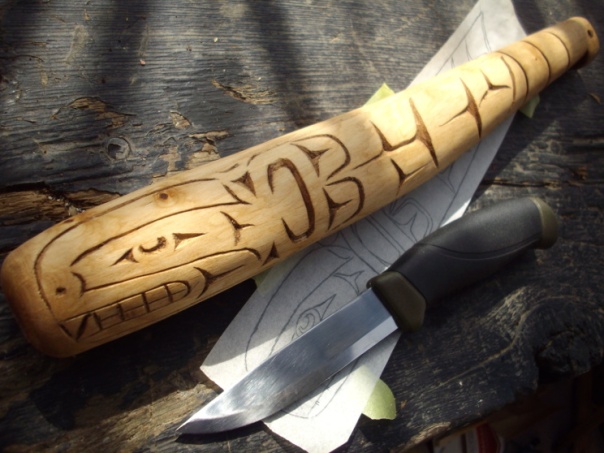
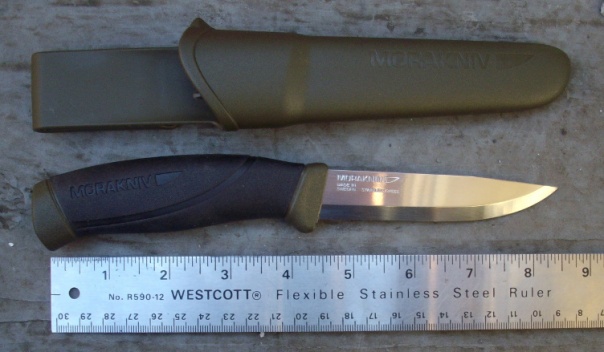
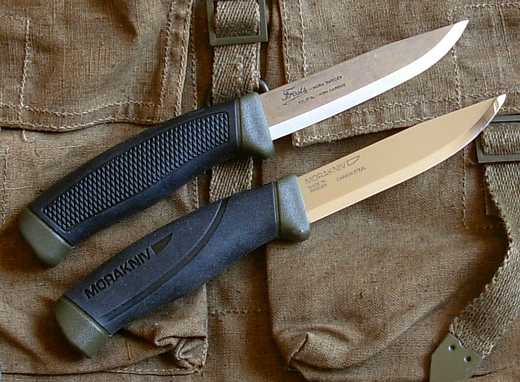
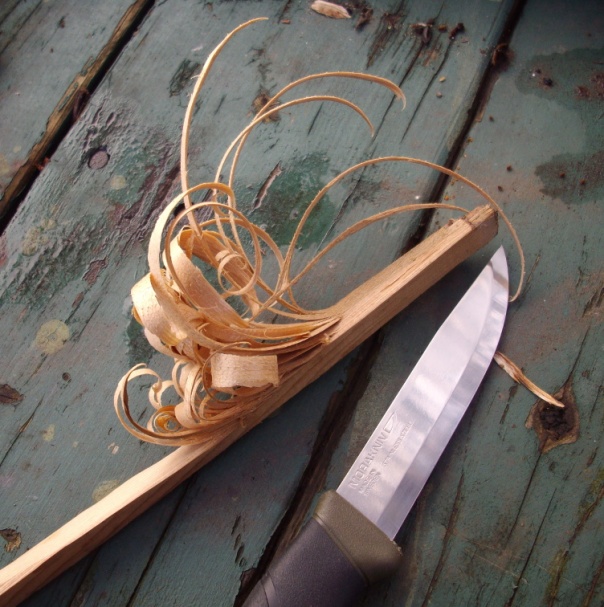
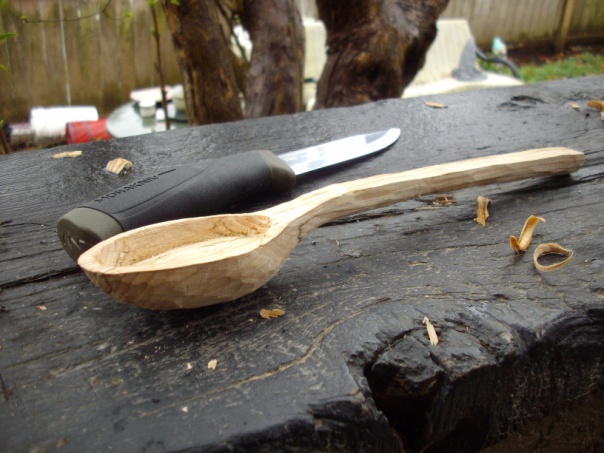


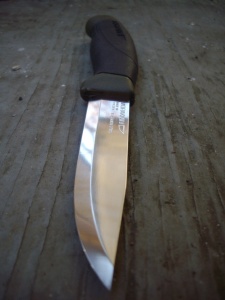
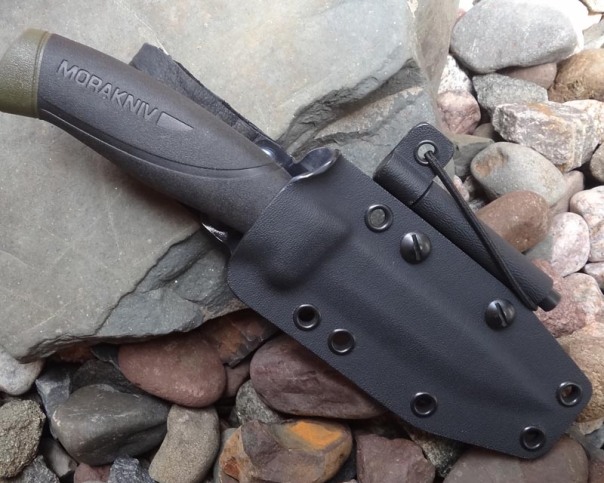

Warrior Publications! Brought to you by Mora Knives of Sweden! :p
Lol…
Have had one of these for years, it is all I need, I do not go anywhere without it and have brought it everywhere on the coast and used it for just about everything, and it is still in perfect condition. What I love about it, is how small it is, and its light weight makes it perfect to take hunting or harvesting, because you have to have one but really don’t want to lug extra weight around in the bush.
I agree, it’s so slim and light weight that you hardly notice it, unlike larger, heavier knives that constantly remind you they’re on your belt, pulling your pants down or getting hung up on chairs, etc.
Reblogged this on Free UniversE-ity.
Hi Zig,
Thanks for sharing nice post. My own point of view,”Kershaw Ken Onion Leek Folding KnifeKershaw Ken Onion Leek Folding Knife” is excellent. It is truly impressive to see the quality of craftsmanship that goes into these knives. Straight out of the box, it is razor sharp. It just has a nice, heavy, and balanced feel in your hand. Would highly recommend this guy. Thank you…
Regards,
Kayla Robey
Great article! These mora knives are just awesome! I haven’t actually used this one that you have reviewed but I own 6 other Mora knives and just love the quality.
I like the belt sheath – need to get me one of those.
Thank you for the review. I like your custom companion sheath.
Have had a problem with edge chipping on my stainless companion. Likely an issue with my usage and sharpening technique. Most noticeable chipping occurs when clearing twigs from a branch.